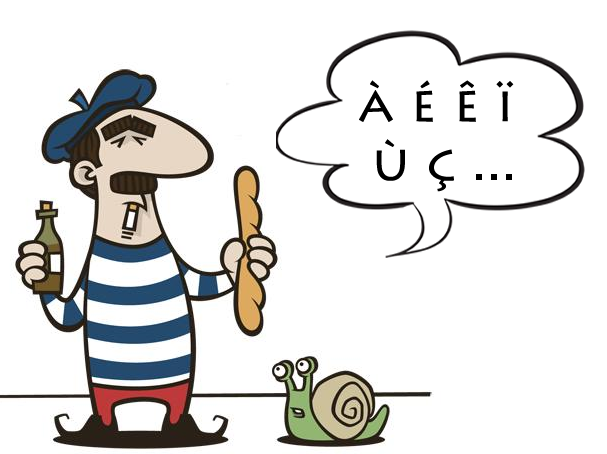Language/French/Pronunciation/Accents-(advanced-level)
This article is a more detailed version of this article.
In French there are 5 kinds of diacritics, which people erroneously call "accents":
- The Accute Accent (é),
- the Grave Accent (è),
- the Circumflex (ê),
- the Diaeresis (ë) (erroneously called Umlauts),
- the Cedilla (ç).
Most diacritics indicate that the vowel is pronounced differently than the way it is when unmarked. However there isn't exactly a general pattern.
E
E is the tricky one. It's the only vowel that takes every diacritical mark. But these sound changes are very minor.
(e) can be pronounced in several different ways, but in most circumstances its /ɛ/ as in "bed" (in the American Accent)
- (é) is pronounced /e/ as in "play." Returning to the Grave Accent,
- (è) is pronounced the same as (e), /ɛ/. An accent grave on È has a low and long sound, but shorter than the circonflexe accent. Grève (strike) ~ grèève (pronounced like goat sound)
Acute accent
The acute accent does not have any equivalent in English. I could say it is a high pitch "E", mid-way between E and I ("ee" in English) Examples : Été (summer), élégance... There is no real rule for you to learn when accents appear in words.
Grave accent
The Grave Accent occurs over A, E, and U. For (à) and (ù), it doesn't indicate a sound change.
ù
(ù) is only present in "où" but (à) is used in a few other words. ù is only used in 1 word in the whole language (and it has its own key on our keyboards...). "Où" means where, "ou" means or. No difference in pronunciation
À
It has only a historical origin for "À", not to confuse it with "A" which is present form of avoir (to have).
The Circumflex
The Circumflex is used over all vowels except Y. It indicates the following sound changes:
- a /a/ (Fr. là) -> â /ɑ/ (palm)
- e /e/ (play) -> ê /ɛ/ (bed)
- i /i/ (fleece) -> î /i/ (no change)
- o /ɔ/ (cloth) -> ô /o/ (Fr. mot)
- u /y/ (Fr. juge) -> û /y/ (no change)
All the vowels with a circonflexe accent ("^") are supposed to be stressed over a longer period of time. Examples :
- Bête (beast, dumb) ~ bêêêête
- Pâtes (pastas) ~ pââââtes (that's overly exaggerated)
Often, the circonflexe ^ was substituted to the combo vowel+"s" at some point in history, like this example : Isles -> Îles (islands)
The Diaresis
The Diaresis (or Tréma, in French) is used over E, I, U, and Y. If there's a vowel cluster, it indicates that the marked vowel is not part of a true Diphthong. In English that means it's pronounced separately, not the way the vowel cluster normally is without the diaresis. For example, the oï in "astéroïde" is pronounced /ɔ.i/ not /wa/ as in "oiseau," which is that vowel cluster's normal sound. Another example is "haïr" /a.iʁ/ and "vrai" /vʁɛ/. Here's the rest: (ë) is /ɛ/ as in "bed" (ï) is /i/ "heat" (ü) is /y/ as in the French "dur" (ÿ) is only used in proper nouns and is pronounced as /i/.
The Cedilla
The Cedilla doesn't indicate sound changes. The Cedilla is used to indicate that Ç is pronounced /s/ when preceding A, O, or U. Normally C is only pronounced /s/ when preceding E, I or Y. The Cedilla is for the exceptions.
Unfortunately there's a lot more but this should cover the essential stuff.
Links
Here's an exhaustive table of French pronunciation: http://omniglot.com/writing/french.htm
Here's Wikipedia's list of French vowel clusters: https://en.wikipedia.org/wiki/French_orthography#Vowels_and_combinations_of_vowel_letters
Hope that helps.
Good luck!


